Genre: Run-‘N-Gun Developer: Psikyo Publisher: Capcom Players: 1-2 Released: 2001
As a Dreamcast owner, I was especially pleased with the support Capcom gave the console. The famed publisher didn’t settle for quick cash-grab conversions of the games it released on the PlayStation. Rather, it brought its A game and gave Sega’s final console some special attention. The staunch backing we saw on Saturn, with a flurry of great fighting games, carried over with several standout titles, including a Resident Evil exclusive.
One area where Capcom focused its releases was giving the Dreamcast exclusive ports of its arcade titles. Both the excellent Power Stone games, Plasma Sword, and Project Justice were among the games that only saw a home release on Dreamcast. Along with these fighters was Cannon Spike, an excellent run-‘n-gun shooter that no one I knew had ever heard of. As we poured over the images in game magazines of Cammy and Charlie from the Street Fighter series, we couldn’t make heads or tails of it. Fighting game characters in a shooter? Could that even work? The answer is definitely “yes.”
Running on Sega’s powerful Naomi arcade hardware, Cannon Spike was a no-brainer for a Dreamcast port, but it also added some great variety to Capcom’s fighter-heavy lineup. Take Robotron 2084. and add big robots and vehicles and some Street Fighter characters, and then watch them go! The game was known as Gun Spike in Japan but reportedly got the name change because “Cannon Spike” is one of Cammy’s in-game special attacks.
The plot is as thin as one would expect for a run-‘n-gun. The world’s economy was in ruins, leading to widespread warfare and terrorism. As part of the Anti-Robot Special Force, players had to destroy every robot they found. For some reason, ARSF included Cammy and Charlie from Street Fighter, as well as Arthur from the Ghosts ‘n Goblins series. Rounding out the initial cast were champion skateboarder Shiba Shintaro and Arthur’s companion, the cyborg Simone. Two additional characters, Darkstalkers’ B.B. Hood and Mega Man, could be accessed by pressing right or left on the control pad at the character select screen. There was never any explanation for this eclectic cast, but it wasn’t really needed. Personally, I found the mix fun since it added some Capcom flair to the game.
Sega’s Naomi board did a good job here, providing fast and constant action with huge bosses; however, I got the feeling that its full power wasn’t even remotely reached. The 3D models were smooth and detailed though the environments were kind of sparse. Could that have been due to the need to accommodate so many enemies in such a small space? Possibly, but I think there could have been more detail. It was great to take on bunches of enemies and large, articulated bosses, but it couldn’t quite make up for the empty environments. Such nitpicking is likely just me yelling at clouds, so don’t take it as a real knock against the game.
Undoubtedly, the best way to play Cannon Spike was with the Dreamcast arcade stick since it most closely mimicked the feel of the arcade original’s control scheme. For those lacking that option, the standard controller worked well enough, using either the D-pad or analog stick to move. One simply had to move around the stage and shoot everything. A quick issue is that one could only shoot enemies directly in the line of fire, something that would likely cause modern gamers to scream for a second analog stick, Cannon Spike smartly overcame this obstacle by using a button to “mark” or lock onto a foe. In this manner, one could shoot the same enemy regardless of where it moved. Players also had a heavy shot and heavy physical attack to pull off some sweet fighting moves, along with a special attack that granted a bit of invincibility and caused major damage. These special attacks were limited to the number of items in players’ inventory and could be restocked by defeating foes. Finally, there were armor and life power-ups to help against the onslaught.
Cannon Spike emphasized boss fights, and that was both good and bad. On the positive side, fighting huge robotic bosses was awesome. The action was frantic and exciting. Enemies came in waves, and it was possible to get that “in the zone” feeling from moving and shooting enemies. The downside was that the feeling didn’t last very long because the waves were quite short, especially with a second player. Thankfully, Cannon Spike had multiple difficulty levels that helped prolong the challenge and make things more interesting. Moreover, the stage order was different for each character, adding further challenges for those who wanted to try another play style.
For these reasons, Cannon Spike remains fun in short bursts. Break it out every once in a while, when you’re looking for some quick, mindless action. Linger too long, however, and its flaws become readily apparent. The 10 stages can be completed in under an hour, a fact I’m sure many irritated Dreamcast owners learned on release day. Regardless, Cannon Spike should be in every Dreamcast owner’s library. It’s shot up dramatically in price over the years, so don’t pass on it if you can find it for a good price. Grab a friend and take an hour to end the robot menace!

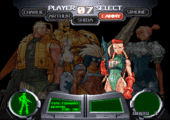
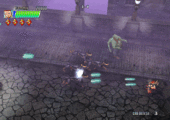
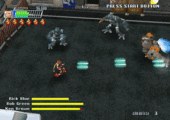
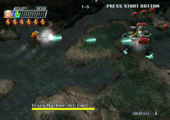
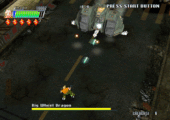
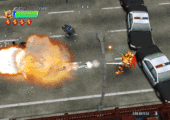
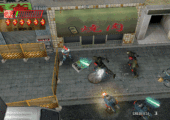
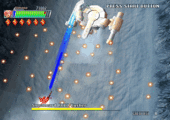
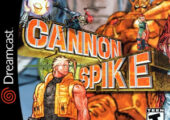
Recent Comments